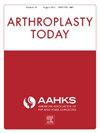Hospital Financial Burden of Surgical Procedures for Periprosthetic Total Hip Arthroplasty Infection
IF 1.5
Q3 ORTHOPEDICS
引用次数: 0
Abstract
Background
For reimbursement purposes, current coding fails to reflect the true complexity and resource utilization of hospital encounters for surgeries performed to treat periprosthetic total hip arthroplasty (THA) infection. Therefore, when compared to aseptic revisions, we sought to determine (1) Is length of stay (LOS) longer for septic surgeries? (2) Are septic procedures more expensive? and (3) How do different surgical procedures for infection compare with aseptic revisions on hospital LOS and charges?
Methods
Retrospective chart review of 596 unilateral THA reoperations (473 patients) performed at a single institution (January 2015 to November 2020). Demographics, professional (ie, physicians), and technical (ie, room, implants) hospital charges per case were compared between 6 different surgery types: (1) aseptic revision (control; n = 364); (2) debridement, antibiotics, and implant retention (n = 11); (3) explantation (n = 145); (4) spacer exchange (n = 7); (5) 2-stage reimplantation (n = 59); and (6) 1-stage reimplantation (n = 10).
Results
Overall, septic surgeries (n = 232) had longer LOS (mean 6.3 vs 3.3 days, P < .001) and 43% higher total charges (P < .001), vs aseptic revisions. Particularly, explantations had longer LOS (7.1 vs 3.3 days) and 56% higher total charges (both P < .001). When compared to aseptic revisions, proportional total charges for septic procedures were debridement, antibiotics, and implant retention +29%, P = .4; explantation +56%, P < .001; spacer exchange +69%, P = .008; 2-stage reimplantation +11%, P = .659; and 1-stage reimplantation +46%, P = .06.
Conclusions
Some surgical procedures performed to treat periprosthetic THA infection are associated with longer LOS and significantly higher hospital charges when compared to aseptic revisions. Reimbursement adjustment is needed as current coding for septic reoperations does not reflect actual hospital resource consumption and this situation may limit access to patient care.
求助全文
约1分钟内获得全文
求助全文
来源期刊

Arthroplasty Today
Medicine-Surgery
CiteScore
2.90
自引率
0.00%
发文量
258
审稿时长
40 weeks
期刊介绍:
Arthroplasty Today is a companion journal to the Journal of Arthroplasty. The journal Arthroplasty Today brings together the clinical and scientific foundations for joint replacement of the hip and knee in an open-access, online format. Arthroplasty Today solicits manuscripts of the highest quality from all areas of scientific endeavor that relate to joint replacement or the treatment of its complications, including those dealing with patient outcomes, economic and policy issues, prosthetic design, biomechanics, biomaterials, and biologic response to arthroplasty. The journal focuses on case reports. It is the purpose of Arthroplasty Today to present material to practicing orthopaedic surgeons that will keep them abreast of developments in the field, prove useful in the care of patients, and aid in understanding the scientific foundation of this subspecialty area of joint replacement. The international members of the Editorial Board provide a worldwide perspective for the journal''s area of interest. Their participation ensures that each issue of Arthroplasty Today provides the reader with timely, peer-reviewed articles of the highest quality.
 求助内容:
求助内容: 应助结果提醒方式:
应助结果提醒方式:


